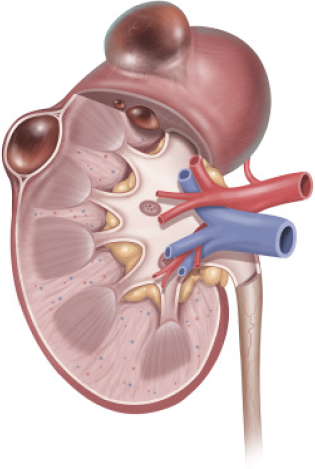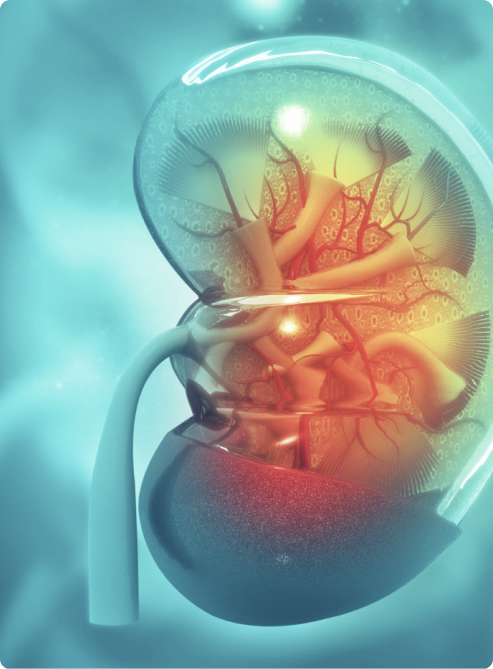Kidney (Renal) Cysts

Kidney (renal) cysts are pockets of fluid that form in your kidneys. Though the exact causes of these cysts are unclear, they occur more frequently in older people. In general, kidney cysts can be classified as simple kidney cysts or complex kidney cysts. Doctors may also use the Bosniak Classification System of Renal Cysts to categorise the type of cyst based on its complexity.
Kidney Cysts Symptoms
Most people with kidney cysts do not experience any symptoms or have problems with the function of their kidneys. If symptoms do occur, you may feel pain in the area between your hip and rib if the cysts grow bigger. You may also get fever and chills if an infection develops. Consult your urologist if you are experiencing any of these symptoms.
Kidney Cysts Diagnosis
Imaging tests are used to confirm the presence of cysts in the kidneys. Your doctor may conduct an abdominal ultrasound and pelvic ultrasound to examine the form or presence of cysts. This method uses painless sound waves to generate images.
A CT scan may also be conducted as a complement to ultrasound in the study of complex renal cysts. This procedure can help distinguish benign cysts from tumours in the kidneys. In this procedure, X-rays and computer software are used to create three-dimensional images that may provide more information to your doctor. You may be injected with a dye to enhance the contrast of the images and will be required to enter a tunnel-shaped device during the imaging process.
An MRI scan is similar to a CT scan but uses radio waves and magnets to generate images. As with the CT scan, you may be injected with a contrast-enhancing dye and will be required to enter a tunnel-shaped device for imaging.
After the scans are completed, kidney cysts are classified as simple or complex cysts. Simple cysts are benign, while complex cysts have the risk of being cancerous. Complex renal cysts can have a thicker wall or solid material inside instead of just fluid.


Kidney (renal) cysts are pockets of fluid that form in your kidneys. Though the exact causes of these cysts are unclear, they occur more frequently in older people. In general, kidney cysts can be classified as simple kidney cysts or complex kidney cysts. Doctors may also use the Bosniak Classification System of Renal Cysts to categorise the type of cyst based on its complexity.
Kidney CYSTS SYMPTOMS
Most people with kidney cysts do not experience any symptoms or have problems with the function of their kidneys. If symptoms do occur, you may feel pain in the area between your hip and rib if the cysts grow bigger. You may also get fever and chills if an infection develops. Consult your urologist if you are experiencing any of these symptoms.

Kidney Cysts diagnosis
Imaging tests are used to confirm the presence of cysts in the kidneys. Your doctor may conduct an abdominal ultrasound and pelvic ultrasound to examine the form or presence of cysts. This method uses painless sound waves to generate images.
A CT scan may also be conducted as a complement to ultrasound in the study of complex renal cysts. This procedure can help distinguish benign cysts from tumours in the kidneys. In this procedure, X-rays and computer software are used to create three-dimensional images that may provide more information to your doctor. You may be injected with a dye to enhance the contrast of the images and will be required to enter a tunnel-shaped device during the imaging process.
An MRI scan is similar to a CT scan but uses radio waves and magnets to generate images. As with the CT scan, you may be injected with a contrast-enhancing dye and will be required to enter a tunnel-shaped device for imaging.
After the scans are completed, kidney cysts are classified as simple or complex cysts. Simple cysts are benign, while complex cysts have the risk of being cancerous. Complex renal cysts can have a thicker wall or solid material inside instead of just fluid.
Kidney Cyst Treatment Options
For kidney cysts that do not cause any problems or discomforts, no treatment is required. Routine monitoring of these cysts will be sufficient. For larger cysts that do cause problems, medical procedures may be required.
Larger cysts may require surgery. During this procedure, you will be under general anaesthesia. This surgery involves the use of a scope with a camera and light on its end called a laparoscope to drain the cyst. The excess tissue will then be either burnt or removed by your doctor.
For complex cysts that may be cancerous, laparoscopic keyhole surgery called Laparoscopic Radical Nephrectomy or Laparoscopic or Robotic Partial Nephrectomy offers good minimally invasive curative surgery.
Seek recommendations on suitable treatment options for Kidney (Renal) Cysts with Colin Teo Urology. Contact us to book an appointment today.